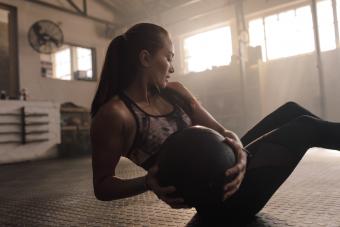
For anyone who wants to be fit from head to toe, understanding core training is essential. It's not enough to have washboard abs. To have a high level of fitness, you need to incorporate all the muscles that make up your body's core. By utilizing all of the necessary muscles in a complete core training workout, you can be stronger and avoid common back problems that plague so many people as they grow older.
The Body's Core
For many avid exercisers, the core is nothing new. They know about it, even if they don't focus on it with specific core exercises. Just like any muscle in the body, your core has to be worked effectively to gain and maintain strength. Proper core training leads to better posture, less back pain and cuts down on the likelihood of injuries.
Core Muscles
These major and minor muscles make up the body's core:
- Transversus abdominis
- Multifidus
- Internal obliques
- External obliques
- Pelvic floor
- Erector spinae
- Gluteus maximus
- Trapezius
- Diaphragm
- Rectus abdominis
- Hip flexors
- Quadratus Lumborum
More Than Abs
As you can see, this is much more than simply your abdominals and core training isn't necessarily about getting those ripped abs that infomercials are constantly talking about. It's about getting a strong stabilizing center that allows you to perform at peak ability. A weak core affects performance in many areas. Even throwing a ball doesn't begin and end at your arms and hands. It starts with a strong center.

Core Training Benefits
Core training helps develop a strong body that not only competes well, but is functional on a daily basis for mundane activities. It's not only athletes who benefit from core training. Even people who aren't very active need a sturdy center that gets them through day-to-day functions comfortably. By working your core, you help ensure a healthier body, through middle age and beyond. The stabilization provided by a strong core can help you avoid injuries.
Core Training Basics
You can train your core with or without equipment. Pilates is an excellent way to work your entire body, including the all-important core. Yoga practitioners and professional dancers have long known the secret to getting a strong core, even before much focus was placed on maintaining this area of the body. The enviable posture of Pilates and yoga devotees, as well as longtime dancers, is a testament to what effective core training can do for you.
Core Training Equipment
Machines and equipment are also available for use for core training. You can also perform exercises with no equipment at all. Instead, you use your body's own resistance or a wall. Equipment utilized for core training include, but are not limited to:
- Stability balls
- Medicine balls
- Incline bench
- Cable pulleys
- BOSU or unstable platforms

Workouts for Core Strength
Some people prefer workouts that seem more like play than exercise. Swimming, tennis, boxing, and biking are all good ways to work your entire body, which trains your core while being fun at the same time. You can work your core with equipment or without, with or without the help of a professional, and still get the same results: a strong center that makes your performances and daily life that much easier and more effective.
Getting Started With Core Training
If you belong to a gym, consult with a personal trainer to develop a core training program just for you, or you can train at home. Whether you work with a professional or go it alone, make sure you incorporate as many of the core muscles as you can to get the full benefit of training this area. Just as you need to work your opposing muscles (biceps and triceps) for a full arm workout, you need to concentrate on your abs and back muscles when working the core.







